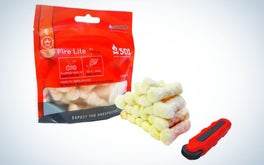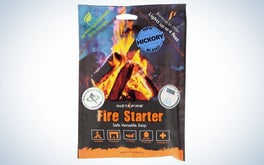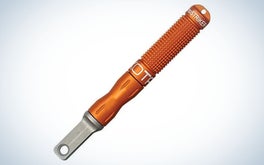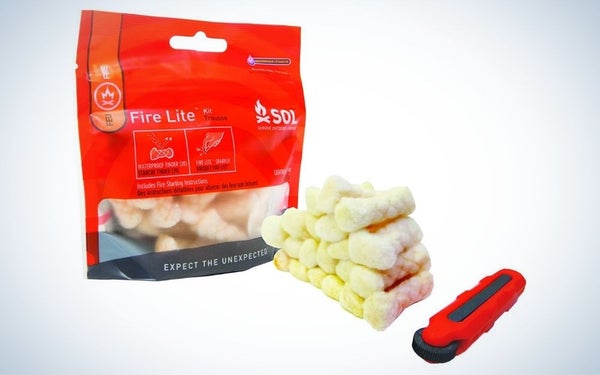| Best Fire Starter Kit |

|
SOL Fire Lite Kit | SEE IT |
LEARN MORE
|
Summary
The Tinder Quik tabs are easy to use: simply pull one end apart to fluff up the fibers. The Fire Lite Sparker works the same way as a disposable lighter, just turn the thumb wheel to generate the sparks that will light the tinder. |
| Best Fire Starter Tinder |

|
Instafire | SEE IT |
LEARN MORE
|
Summary
Easy to use: simply pour a small pile and light it with a flame or spark. It is water resistant, will float on water and continue to burn, and gets to 1000 degrees. |
| Best Fire Starter Rod |

|
Exotac nanoSTRIKER XL | SEE IT |
LEARN MORE
|
Summary
The nanoSTRIKER XL has a ferro rod and striker all built-in. You simply unscrew the parts, reassemble them to expose the rod, and you’ll be making sparks in a flash. |
Fire starters are a camping and survival essential. Fire keeps us warm, dry, and lights up the night. It boils water to make it safe for us to drink. There is also a strong psychological benefit: We feel more relaxed and safer when we’re near a campfire. In a true survival situation, being able to start a fire gives us a sense of control over what’s happening, which helps put us into a more positive mindset.
There are many types of fire starters available, employing various methods and at varied prices. Deciding on the best fire starter for you depends on which one will be reliable in your area’s climate, its size, its price, and its ease of use. The following are the best fire starters available today.
- Best Kit: SOL Fire Lite Kit
- Best Tinder: Instafire
- Best for Wet Conditions: Pull Start Fire
- Best Fire Starter Rod: Exotac nanoSTRIKER XL
- Best for Camping: UCO Sweetfire Strikable Fire Starter
How We Chose The Best Fire Starters
I’ve been studying and practicing survival techniques for over 30 years. In that time, I’ve built countless fires. I’ve used every manner of tool and technique, from disposable lighters to ferrocerium rods and more. I took several considerations into account evaluating the tools offered here.
- Ease of use: Each tool or device must not be overly difficult or complicated. When the chips are down and you need a fire now, simple is best.
- Learning curve: Every survival tool must be practiced with and mastered, ideally well before it is needed. The quicker you can learn the tool’s use and capability, the better.
- Effectiveness: The tool or tinder needs to work well in a variety of conditions—in strong winds, during a rainstorm, or while it’s snowing. Because the reality is, when you really need to start a fire, the weather isn’t going to show you any mercy.
- Value: I don’t like spending a ton of money on something if I don’t have to do so. Neither should you. Each item here provides plenty of bang for your buck.
The Best Fire Starters: Reviews & Recommendations
Best Kit: SOL Fire Lite Kit
Why it Made the Cut: With 20 pieces of Tinder Quik tinder that lights when wet and the windproof Fire Lite sparker, this super-lightweight kit will get a fire going anywhere.
Key Features
- Contains both striker and tinder
- Weight: 0.7 ounce
- Usage: Up to 20 fires
Pros
- Ultra-convenient and easy to use
- Start up to 20 fires with one kit
- Less than $1 per fire started
Cons
- Sparker is small and hard to use if hands are cold/stiff
- Flint on sparker cannot be replaced
The Fire Lite Kit from Survive Outdoor Longer comes with both tinder and sparker, so you have all you need in one lightweight bag. The Tinder Quik tabs are easy to use: simply pull one end apart to fluff up the fibers. The Fire Lite Sparker works the same way as a disposable lighter, just turn the thumb wheel to generate the sparks that will light the tinder.
The Tinder Quik tabs each burn for several minutes, providing plenty of time to light your kindling and get a fire burning in earnest. With 20 of them in the kit, you’ll have plenty to last your entire trip and then some.
This kit also includes instructions on how to select kindling and build your fire from the ground up. Everything is contained in a resealable bag. Just toss it into your pack and you’ll be ready to start a fire anywhere there’s fuel to burn.
Best Tinder: Instafire
Why it Made the Cut: It’s easy to use: simply pour a small pile and light it with a flame or spark. It is water resistant, will float on water and continue to burn, and gets to 1000 degrees.
Key Features
- Weight: 1.75 ounces per package
- Burn Temperature: 1,000°F
- Materials: volcanic rock, recycled wood, food-grade paraffin wax
Pros
- Can be lit by spark or flame
- Use as much or as little as needed
- Very hot and long lasting fire
Cons
- Wind can blow it around
Instafire was featured on Shark Tank in 2015 and has been lighting up the world ever since. The slim package will just about cover the palm of your hand. Inside is about 1.75 ounces of a granular mixture containing pulverized volcanic rock, recycled wood, and a proprietary blend of food-grade paraffin wax. An entire package will burn up to 25 minutes.
To use, you simply open the package and pour out some of the material, enough to cover a quarter or half-dollar will normally suffice. Shape it into a little pile and light. A ferrocerium rod works great with Instafire, as does any disposable lighter.
The material burns at upwards of 1,000°F and will do so for several minutes, easily lighting the rest of your fire materials. You can pour it out on a block of ice or pile of snow and it’ll burn just as bright. We’ve even lit it and then let it float directly on water while it burned. This is an outstanding easy- to-light tinder that will work with virtually any type of fire starter.
Best for Wet Conditions: Pull Start Fire
Key Features
Why it Made the Cut: Easily the longest burning product on our list, it burns hot and bright for a full 30 minutes, and all you need to do is pull a string.
- Burn time: 30 minutes
- Weight: 3.7 ounces
- Dimensions: 5 x 1.1 x 2.1 inches
Pros
- Requires nothing but wood to burn
- Waterproof packaging keeps it protected
- Simple to start
Cons
- May not work if packaging is compromised before lighting
- Heavier and bulkier than other options
- One-time use per package
Pull Start Fire works in any weather conditions and its performance is unaffected by wind, rain, cold, or snow. The set-up is easy. First, peel off the plastic from the package. There are two strings, one on each end of the box. Loop the green string over a log in the fire pit and make sure it is secure. Build the fuel up around the box. Then, quickly pull the red string. With a pop, the box will start to billow smoke and then burst into flames. It works somewhat like a pull-string firecracker, just with less bang and far more flame.
Because it will burn for upwards of half an hour, you’ll have plenty of time to get your kindling started and then some. It is important to note that you should never hold this in your hand when starting. It must be secured tightly to a log before you pull the red string.
Best Fire Starter Rod: Exotac nanoSTRIKER XL
Why it Made the Cut: Exotac has earned a well-deserved reputation for gear that withstands hard use. This ferro rod is a great example.
Key Features
- Dimensions: 3.65 x 0.43 x 0.43 inches
- Weight: 0.71 ounce
- Materials: 6061 anodized aluminum body
Pros
- Ferrocerium rod is replaceable if it gets worn down
- Has a built-in striker
- 3000 strikes per rod
Cons
- Small and could be easy to misplace
- Ferro rod is thin, just 0.25-inch diameter
The nanoSTRIKER XL has a ferro rod and striker all built-in. You simply unscrew the parts, reassemble them to expose the rod, and you’ll be making sparks in a flash. It’s extremely well made and designed to stand up to very rough treatment, as is all of Exotac’s gear.
This ferro rod is an excellent choice for a survival kit because it will work even in rain or snow. It will rain hot sparks down on your tinder with each scrape of the striker. When you’re done, you can collapse it all back up into its original configuration and stow it in a pocket. If you are only looking to buy one fire steel, this is the way to go.
Best for Camping: UCO Sweetfire Strikable Fire Starter
Why it Made the Cut: Ignitor and tinder in one, the Sweetfire ignites with just a swipe against the box, just like a match, and burns for seven minutes.
Key Features
- Usage: up to 20 individual fires
- Burn time: 7 minutes
- Package weight: 4.9 ounces
Pros
- All-in-one product, no need for other components
- Made from sugarcane waste, a renewable resource
- Can make up to 20 fires from one package
Cons
- Won’t light if striker surface on box is wet
The UCO Sweetfire Strikable Fire Starter gains its name from the bagasse from which it is made, which is a sugarcane by-product. This material is used around the world as a renewable biofuel. It’s combined with vegetable wax to create a long-lasting burn. There are 20 match points in each box, grouped in sets of five.
To use, simply break one off and strike the red tip against the side of the box, exactly as you would a match. It will flare to light with a vengeance, then die back to a steady flame. It can be stood on end, similar to a candle, inside your fire build. It will burn for about seven minutes.
UCO includes a spare striker surface in the box—a nice touch—so you’ll always have a spare striker. You also can break the package contents up into two fire kits. If it gets wet, it’ll light once it dries.
Things to Consider Before Buying The Best Fire Starters
Always take into account where you’ll be building a fire when selecting a fire starter. If that will be a damp climate, you’ll need something that will work even if it gets wet, such as the nanoSTRIKER XL. On the other hand, if you’re just going to a campground for the weekend and you know you’ll have reliable sources of seasoned firewood, the UCO Sweetfire is a fine campfire starter and might be all you’ll need to add to your camping gear.
If you’re on the trail, you should carry at least two different ways to light a fire. One of the best is a simple disposable lighter. But if it runs out of fuel, or if the temperature is too cold for the fuel to vaporize properly and light, then any of the products we’ve recommended will work well.
In addition to a fire starter, make sure you always have reliable tinder with you, just in case you can’t source it from Mother Nature. Practice with your newly purchased fire starter so you know how it operates. Test it in poor weather, too, so you know what its limitations might be well before you need it.
FAQs
Q: Do you need a fire starter?
Every time you venture out into the field, you should have multiple means of lighting a fire with you. Fire will provide warmth and light, boil water to make it safe to drink, and is a reassuring presence.
Q: Do fire starters expire?
Some products on the market have a limited life in terms of maximum effectiveness. Ferrocerium rods will last a very long time if they are kept covered.
Q: How to start a fire?
Start with tinder, which is typically a light, fluffy material that’s easily lit. Build a teepee over the tinder using dry sticks that are about the thickness of a toothpick or a hair larger. Light the tinder and let it ignite the kindling. Slowly add thicker sticks until the fire is the size you desire.
Final Thoughts on the Best Fire Starters
If we had to pick just one of these to be the absolute best fire starter, it would be the nanoSTRIKER XL from Exotac. It will shed a shower of hot sparks up to 5,000 times, under any conditions. It’s simple to operate, easy to pack, and dead reliable. All you need is tinder.





